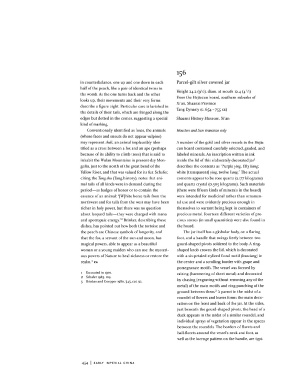Page 455 - The Golden Age of Chinese Archaeology: Celebrated Discoveries from the People’s Republic of China
P. 455
156
in counterbalance, one up and one down in each Parcel-gilt silver covered jar
half of the peach, like a pair of identical twins in
7
Height 24.2 (9 y 2) f diam. at mouth 12.4 (4 / 8)
the womb. As the one turns back and the other
From the Hejiacun hoard, southern suburbs of
looks up, their movements and their very forms
Xi'an, Shaanxi Province
describe a figure eight. Particular care is lavished in
the details of their tails, which are fringed along the Tang Dynasty (c. 654 - 755 CE)
edges but dotted in the center, suggesting a special Shaanxi History Museum, Xi'an
kind of marking.
Conventionally identified as foxes, the animals Houston and San Francisco only
(whose faces and snouts do not appear vulpine)
may represent shell, an animal implausibly iden- A number of the gold and silver vessels in the Hejia-
tified as a cross between a fox and an ape (perhaps cun hoard contained carefully selected, graded, and
because of its ability to climb trees) that is said to labeled minerals. An inscription written in ink
inhabit the Wulan Mountains in present-day Mon- inside the lid of this elaborately decorated jar 1
golia, just to the north of the great bend of the describes the contents as "Purple ying, fifty Hang;
Yellow River, and that was valued for its fur. Schafer, white [transparent] ying, twelve liang" The actual
citing the Tang shu (Tang history), notes that ani- contents appear to be rose quartz (2.177 kilograms)
mal tails of all kinds were in demand during the and quartz crystal (0.505 kilograms). Such materials
period—as badges of honor or to contain the (there were fifteen kinds of minerals in the hoard)
essence of an animal: "[W]hite horse tails from the were intended for medicinal rather than ornamen-
northwest and fox tails from the west may have been tal use and were evidently precious enough in
richer in holy power, but there was no question themselves to warrant being kept in containers of
about leopard tails—they were charged with mana precious metal. Fourteen different varieties of pre-
2
and apotropaic energy." Brinker, describing these cious stones (in small quantities) were also found in
dishes, has pointed out how both the tortoise and the hoard.
the peach are Chinese symbols of longevity, and The jar itself has a globular body, on a flaring
that the fox, a servant of the sun and moon, has foot, and a handle that swings freely between two
magical powers, able to appear as a beautiful gourd-shaped pivots soldered to the body. A ring-
woman or a young maiden who can use the mysteri- shaped knob crowns the lid, which is decorated
ous powers of Nature to heal sickness or restore the with a six-petaled stylized floral motif (baoxiang) in
realm. 3 RW the center and a scrolling border with grape and
pomegranate motifs. The vessel was formed by
1 Excavated in 1970. raising (hammering of sheet metal) and decorated
2 Schafer 1963,109.
3 Brinker and Goepper 1980, 343, cat. 92. by chasing (engraving without removing any of the
metal) of the main motifs and ring-punching of the
2
ground between them. A parrot in the midst of a
roundel of flowers and leaves forms the main deco-
ration on the front and back of the jar. At the sides,
just beneath the gourd-shaped pivots, the head of a
duck appears in the midst of a similar roundel, and
individual sprays of vegetation appear in the spaces
between the roundels. The borders of florets and
half-florets around the vessel's neck and foot, as
well as the lozenge pattern on the handle, are typi-
454 | E A R L Y I M P E R I A L C H I N A

